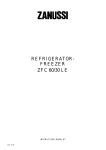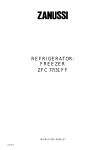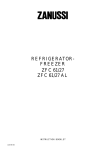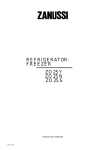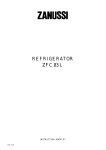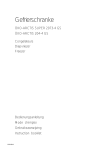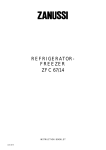Download Zanussi ZFC 282 C Instruction manual
Transcript
REFRIGERADOR REFRIGERATOR FRIGORIFICO ZFC 282 C LIBRO DE INSTRUCCIONES 2222 151-51 INSTRUCTION BOOKLET MANUAL DE INSTRUÇÕES CONTENTS Warnings . . . . . . . . . . . . Installation . . . . . . . . . . . Location . . . . . . . . . . . . Rear spacers . . . . . . . . . . . Power connection . . . . . . . . . Cleaning the appliance’s interior . . . . Changing the opening direction of the door Changing the opening direction of the Use . . . . . . . . . . . . . . Operation - Temperature adjustment . . Fresh food refrigeration . . . . . . . Movable shelves . . . . . . . . . Positioning the door shelves . . . . . Frozen food storage . . . . . . . . Thawing . . . . . . . . . . . . Making ice cubes . . . . . . . . . Defrosting . . . . . . . . . . . Maintenance . . . . . . . . . . . Periodical cleaning. . . . . . . . . Idle periods . . . . . . . . . . . Interior light bulb . . . . . . . . . Something not working . . . . . . . . . . . . . . . . . . . . . . . . . . . . . . . . . . . . . . . . . . . . . . . . . . . . . . . . compartment door . . . . . . . . . . . . . . . . . . . . . . . . . . . . . . . . . . . . . . . . . . . . . . . . . . . . . . . . . . . . . . . . . . . . . . . . . . . . . . . . . . . . . . . . . . . . . . . . . . Warning! . . . . . . . . . . . . . . . . . . . . . . . . . . . . . . . . . . . . . . . . . . . . . . . . . . . . . . . . . . . . . . . . . . . . . . . . . . . . . . . . . . . . . . . . . . . . . . . . . . . . . . . . . . . . . . The appliance which you have just purchased has been very accurately controlled throughout the entire manufacturing process. Nevertheless, should any problem arise during usage, whether it be during the warranty period, or when such period has expired, please contact your nearest Zanussi Service Centre immediately. 10 . . . . . . . . . . . . . . . . . . . . . . . . . . . . . . . . . . . . . . . . . . . . . . . . . . . . . . . . . . . . . . . . . . . . . . . . . . . . . . . . . . . . . . . . Page Page Page Page Page Page Page Page Page Page Page Page Page Page Page Page Page Page Page Page Page Page 600 Closed door 43 600 D223 Open door The address and telephone number of this Centre can be easily found in the enclosed List or by looking in the telephone directory, under Zanussi. Our Zanussi Service Network is at your complete disposal, to serve you with maximum speed and efficiency, all you have to do is call. . . . . . . . . . . . . . . . . . . . . . . Appliance height: 1380 mm 1180 We congratulate you on your choice. Read this instruction manual carefully and follow the recommendations it provides to benefit from years of excellent service. . . . . . . . . . . . . . . . . . . . . . . 595 The appliance which you have just bought is supplied not only with the instruction manual, but also with a Warranty Card Certificate, on the back of which are written the relative conditions. Please fill in the necessary details on the Card Certificate and send it to the Zanussi Centre covering the area in which the appliance is to be installed. (See list of Zanussi network centres). . . . . . . . . . . . . . . . . . . . . . . 643 D224 11 12 12 12 12 12 13 13 14 14 14 14 15 15 15 15 16 17 17 17 17 17 WARNINGS It is most important that this instruction book should be retained with the appliance for future reference. Should the appliance be sold or transferred to another owner, or should you move house and leave the appliance, always ensure that the book is supplied with the appliance in order that the new owner can be acquainted with the functioning of the appliance and the relevant warnings. These warnings are provided in the interest of safety. You must read them carefully before installing or using the appliance. ª This appliance is designed to be operated by adults. Children should not be allowed to tamper with the controls or play with the product. ª Any electrical work required to install this appliance should be carried out by a qualified electrician or competent person. ª This product should be serviced by an authorized Service Centre, and only genuine spare parts should be used. ª It is dangerous to alter the specifications or modify this product in any way. ª Care must be taken to ensure that the appliance does not stand on the electrical supply cable. ª The domestic refrigerators and freezers are designed to be used specifically for the storage of edible foodstuffs only. ª The inner lining of the appliance consists of channels through which the refrigerant passes. If these should be punctured this would damage the appliance beyond repair and cause food loss. DO NOT USE SHARP INSTRUMENTS to scrape off frost or ice. Frost may be removed by using the scraper provided. Under no circumstances should solid ice be forced off the liner. Solid ice should be allowed to thaw when defrosting the appliance. See defrost instructions. ª Do not place carbonated or fizzy drinks in the freezer as it creates pressure on the container, which may cause it to explode, resulting in damage to the appliance. ª This appliance is heavy. Care should be taken when moving it. ª Ice lollies can cause frost burns if consumed straight from the appliance. ª Under no circumstances should you attempt to repair the appliance yourself. Repairs carried out by inexperienced persons may cause injury or more serious malfunctioning. Refer to your local Service Centre, and always insist on genuine spare parts. ª This appliance does not contain gasses which could damage the ozone layer, in either its refrigerant circuit or insulation materials; it must nevertheless be disposed of in a proper manner, in accordance with regulations for protection of the environment. ª Frozen food must not be re-frozen once it has been thawed out. ª Manufacturers’ storage recommendations should be strictly adhered to. Refer to relevant instructions. ª There are working parts in this product which heat up. Always ensure that there is adequate ventilation as a failure to do this will result in component failure and possible food loss. See installation instructions. ª Parts which heat up should not be exposed. Wherever possible the back of the product should be against a wall. ª Before any cleaning or maintenance work is carried out, be sure to switch off and unplug the appliance. ª If the appliance has been transported horizontally, it is possible that the oil contained in the compressor flows in the refrigerant circuit. It is advisable to wait at least two hours before connecting the appliance to allow the oil to flow back in the compressor. 11 INSTALLATION Fig. 2 If this refrigerator featuring magnetic door seals is to replace an older appliance having a spring lock on the door or lid, be sure to make that spring lock unusable before you discard the old appliance. This will prevent it from becoming a death-trap for a child. Location The appliance should be installed well away from sources of heat such as radiators, boilers, direct sunlight etc. Best performance is obtained with ambient temperature between +18°C and +43°C (class T); +18°C and +38°C (class ST); +16°C and +32°C (class N); +10°C and +32°C (class SN). The class of your appliance is shown on its rating plate. Make sure that there is nothing hindering air circulation at the back, bottom, or top of the appliance. To achieve the best performance when the appliance is set under a wall cabinet the top of the appliance should be at least 5 mm away from the base of the cabinet (Fig. 1/A). However, the appliance should ideally not be installed underneath wall cabinets (as shown in Fig. 1/B). One or more adjustable feet mounted on the base of the appliance make it possible to set it perfectly level. Fig. 1 min. 2 50 cm A B min. 2 50 cm min. 2 50 cm PR153 Power connection Before plugging in, ensure that the voltage and frequency shown on the serial number plate correspond to your domestic power supply. Voltage can vary by ±6% of the rated voltage. For operation with different voltages, a suitably sized auto-transformer must be used. The appliance must be earthed. The power supply cable plug is provided with a contact for this purpose. If the domestic power supply socket is not earthed, connect the appliance to a separate earth in compliance with current regulations, consulting a specialist technician. The Manufacturer declines all responsibility if the above safety precautions are not observed. This appliance complies with EEC directive number 87/308 of 2/6/87 relative to radio interference suppression. This appliance complies with the following E.E.C. Directives: - 73/23 EEC of 19.2.73 (Low Voltage Directive) and subsequent modifications; - 89/336 EEC of 3.5.89 (Electromagnetic Compatibility Directive) and subsequent modifications. Cleaning the appliance’s interior D584 Rear spacers In the bag with the documentation, there are two spacers which must be fitted as shown in the figure 2. Slacken the screws and insert the spacer under the screw head, then re-tighten the screws. 12 Before using the appliance for the first time, wash all internal parts with lukewarm water and neutral soap so as to remove the typical «new» smell and then drv thoroughly. Do not use detergents or abrasive powders as these will damage the finish. Fig. 3 Changing the opening direction of the door Unplug the appliance before performing the following operations: Remove the ventilation grille (D-Fig. 4). Unscrew the bottom hinge (E-Fig. 4). Remove the screws of the bracket with foot (I) and levelling foot (H) and reassemble them on the opposite side (Fig. 3). Remove the door from the upper pivot (A-Fig. 5). Remove the pivot and the washer (A+B-Fig. 5) from the upper hinge (C), then mount these on the opposite side. Re-assemble the door. Screw down the bottom hinge (E-Fig. 4) on the opposite side, using the screws previously removed. Detach the plug (F-Fig. 4) from the ventilation grille (D). To do this, press it in the direction of the arrow. Insert the plug (G), which is supplied with the appliance, into the hole left free on the opposite side. Re-assemble the ventilation grille. Reverse the direction of the handle (Fig. 6). H I D691 Fig. 4 E F F F D F D432 Fig. 5 C Changing the opening direction of the compartment door (Fig. 7) Remove pin (1). Remove the door. Pin (4) could drop out when this operation is carried out; if so, it must be retrieved for fitting on the opposite side. Remove bush (5) and fit it on the opposite side. Remove the catch (3) and fit it on the opposite side. Fit pin (4) on the opposite side. Reposition the door and insert pin (1), pressing it into place. Warning After having reversed the opening direction of the door, check that the door gasket is adherent to the cabinet. If the ambient temperature is cold (i.e. in Winter), the gasket may not fit perfectly to the cabinet. In that case, wait for natural fitting of the gasket or accelerate this process by heating up the part involved with a normal hairdrier. B A D427 Fig. 6 D162 Fig. 7 4 3 2 D164 5 1 13 USE Operation - Temperature adjustment Fresh food refrigeration Turn the thermostat knob clockwise beyond position «O» to the required setting. A medium setting is generally the most suitable. Temperature is adjusted automatically and may be increased (less cold) by turning the knob towards the lower numbers, or may be decreased (colder) by turning it towards the higher numbers. The correct position, however, must be located by taking into account that the internal temperature depends on the following factors: The refrigerator compartment is suitable for cooling drinks and for normal food storage. To obtain the best performance, do not store warm food or evaporating liquids in the refrigerator, do cover or wrap the food, particularly if it has a strong flavour. Do not cover the shelves with any protective material, such as paper, cardboard or plastic, which may obstruct the air circulation through them. To help you use refrigerator correctly, here are some useful hints: ambient temperature; the number of times the door is opened; the amount of food stored; the location of the appliance. Operation is stopped by turning the control knob until its pointer coincides with symbol «O». In this refrigerator incorporating a 2-star ( ) evaporator, the temperature in the refrigerator can be adjusted by means of the thermostat and also by means of the conveyor (Fig. 8). To get less cold slightly raise the conveyor and push it in all the way, to reduce the temperature return it to its initial position. Cooked food, cold cuts, jelly, etc.: these should be well covered and can be stored on any of the shelves. Fruit & vegetables: these should be thoroughly cleaned and placed in the bottom drawer. Butter & cheese: these should be placed in special airtight containers or wrapped in aluminium foil or polythene bags to exclude as much air as possible. Milk bottles: these should have a cap and should be stored in the bottle rack on the door. Raw meat (beef, pork, lamb & game): wrap in polythene bags and place on the top shelf, immediately underneath the evaporator. Fig. 8 Movable shelves Fig. 9 The walls of the refrigerator are equipped with a series of runners so that the shelves can be positioned as desired. D182 D040 14 Positioning the door shelves (Fig. 10-11) Frozen food storage To permit storage of food packages of various sizes, the door shelves can be adjusted in height. To make these adjustments proceed as follows: The compartment marked by the symbol is suitable for storing frozen food and, to obtain the best results, make sure the thermostat knob is set near the coldest setting (if ambient temperature is low-i.e., less than 20°C - it is necessary to adjust the conveyor in such a way as to reduce the temperature in the refrigerator compartment). With this thermostat knob setting, the temperature in the refrigerator compartment could fall below 0°C. If this occurs readjust the knob so as to increase the temperature. Furthermore, make sure that: the frozen food to be stored has been kept at the proper temperature in the shop; transport of frozen food from the shop to the evaporator compartment is carried out in a brief time; do not exceed the storage time indicated on packages by the food manufacturer. After an idle period it is necessary to let the appliance run for at least two hours with the thermostat knob set on the coldest setting before placing any frozen food in this compartment. If no frozen food is stored in the evaporator, it is advisable to adjust the conveyor so as to reduce the temperature in the refrigerator compartment thus reducing energy consumption and improving food refrigeration performance. Never put fizzy drinks in the 2-star ( ) compartment as they might well burst. A word of warning about ice lollies: they should not be eaten straight out of the 2-star ( ) compartment as this might cause cold burns. Gradually pull the shelf in the direction of the arrows until it comes free, then reposition as required (Fig. 10). Fig. 10 D064 For more thorough cleaning, the top door shelf can be removed by pulling it in the direction of the arrows, then refitting it in position (Fig. 11). Fig. 11 D066 Thawing Frozen food, prior to being used, can be thawed in the refrigerator or at room temperature depending on the time available for this operation. Small pieces may even be cooked still frozen, directly from the evaporator; in this case, though, cooking will take longer. Making ice cubes The refrigerator is provided with an ice cube tray. This tray should be filled with drinking water and then placed in the evaporator compartment. Do not use metal tools to remove the tray when it is stuck-frozen inside the compartment. 15 Defrosting While in operation, the refrigerated surfaces of the evaporator become progressively covered with frost. This frost, which acts as a thermal insulator and thus prevents the cold from reaching the food, should be removed at regular intervals, otherwise, there will be a marked rise of temperature in the compartment concerned and a wastefull increase in power consumption. To carry out complete defrosting push the button at the centre of the thermostat knob (Fig. 12). Remove the plug from the drain hole in the water collecting tray. Place a basin under the drain hole in the tray to collect the defrost water (Fig. 13). When defrosting is completed, operation is resumed automatically. Remove the defrost water which has collected in the basin placed under the collecting tray. Refit the previously removed plug into the drain hole. Defrosting should be done when there is no food in the 2-star ( ) compartment. Fig. 13 Fig. 12 D137 D225 16 MAINTENANCE Before carrying out any maintenance operation, always disconnect the plug from the wall socket. Periodical cleaning Wash the interior of the appliance with lukewarm water and sodium bicarbonate. Clean cabinet outer surfaces with a silicone-wax spray. The condenser and compressor should be cleaned using a brush or a vacuum cleaner. This latter operation will maintain the appliance’s excellent standards of performance and save energy. To avoid water spillage it is recommended that the water drain collector (Fig. 13) is periodically cleaned. Interior light bulb The light inside the refrigerator compartment is easy to get at. All you have to do is to remove the lamp from the fitting itself. If the light does not come on when the door is opened, check that it is screwed into place properly. If it still does not light up, change the bulb. Fig. 14 Idle periods During periods when the appliance is not used, you should take the following precautions: remove the plug from the wall socket; remove all food from the appliance; defrost and clean the interior and all accessories; leave the door slightly open, thus letting air circulate and preventing the formation of mould and unpleasant smells. D025 SOMETHING NOT WORKING If the appliance is not functioning properly check that: the plug is firmly in the wall socket and the mains power switch is on; there is no power failure and the thermostat is set to the correct position. Furthermore: If the appliance seems too noisy check that the sides are not touching furniture that can transmit or amplify noise or vibration. Also, check that the piping of the refrigerant system does not vibrate. If your appliance is still not working properly after making the above checks, contact your local dealer or the neares service centre. To obtain fast service, it is essential that when you apply for it you specify the model and serial number of your appliance which can be found inside the appliance at the bottom on the left hand side. 17










